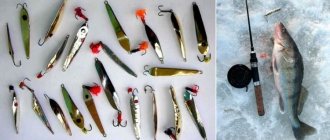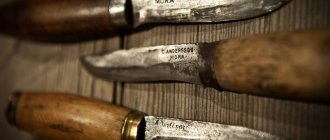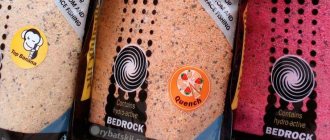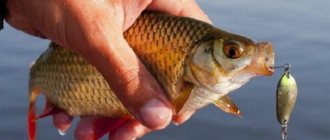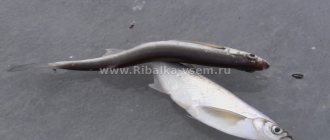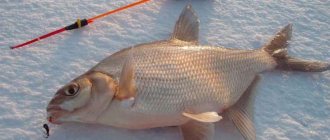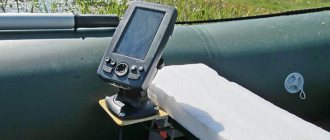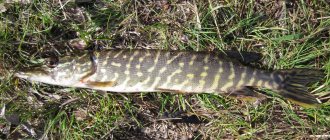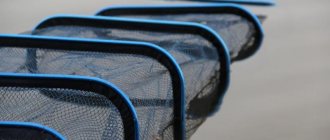DIY bait recipes for winter fishing
Universal bait
A great variety of universal fertilizers for winter fishing have been created. The simplest recipe for homemade complementary feeding is this:
Compound:
- Hercules;
- Cake;
- Crushed or breadcrumbs;
- Vanillin;
- Clay;
- Water.
You can do this fertilizing right on the pond. You just need to combine all the ingredients, mix well and form small balls. All!
There are also a huge number of ready-made baits. For example, "Moth Cloud". It contains bloodworm, hemp, cinnamon, mayfly, betaine.
Bait for perch
Perch is a predatory fish and the bait for it should be based on animal origin. This composition has proven itself to be excellent:
- Groundbait base (Sludge, clay, breadcrumbs, biscuit);
- Bloodworm;
- Chopped worms.
- Amphipods.
All this is mixed in approximately equal quantities (basics 2 parts) and rolled into balls with a diameter of 5-7 centimeters.
You can also add a little shrimp meat, and if you have such exotic products as dried blood and scales, then add that too - it works great.
Bait for crucian carp
In small lakes and ponds, crucian carp burrow into the mud in winter and hibernate. It's useless to catch him here. But in large bodies of water it may well please the fisherman. It bites best on a clear day. The bait for crucian carp should be light and begin to crumble before it even falls to the bottom.
The animal component should be there in minimal quantities so that predatory fish do not approach, otherwise the crucian carp will not come close.
The simplest and most effective feeding consists of:
- Breadcrumbs;
- A little bloodworm and chopped worms.
Bait for roach
In winter, roach bites better than other types of fish, so fishermen mainly focus on it when using bait. We offer an interesting and simple recipe for “raft” bait.
Compound:
- Base (crushed or breadcrumbs) - 300-400 g;
- Roasted sunflower seeds - 1 cup;
- Tangerine peel (dried in the oven) - half a glass;
- Flour - 2 tbsp. spoons.
Everything is mixed and diluted with water.
Bait for bream
Water transparency increases greatly in winter. Therefore, winter complementary feeding is designed primarily to create a cloudy column in the water.
To make winter food for bream you need:
- Base, about a kilogram (breadcrumbs);
- A glass of roasted sunflower seeds;
- Oatmeal (half a cup);
- Split peas (glass).
First you need to prepare pea porridge. To do this, add peas to twice the volume of boiling water. Bring to a boil and simmer over low heat for a long time, stirring frequently until a homogeneous mass is formed.
After this, take breadcrumbs or regular crackers pre-ground through a meat grinder or blender, rolled oats (also ground through a meat grinder) and seeds crushed in a mortar.
Combine all this and mix, and then add pea porridge.
Stir the resulting substance with your hands. The fertilizer should easily form into a lump, which should fall apart when pressed lightly. Ready! Already directly while fishing, it is good to add bloodworms to the balls with complementary foods.
Groundbait for dace
In the dead of winter, dace gathers in small flocks and moves to the depths. In the pits. There he prefers to sit until the thaw. When it gets warmer, this curious fish swims out into shallow water. To a depth of up to 3 meters. To those areas where remnants of algae remain. The best fishing for dace in winter continues for 1-3 weeks after freeze-up; the best dace is caught in the morning. After the thaw begins, the bite can continue all day and even at night.
Bait will not be superfluous for dace in winter.
It is made from:
- Vegetable base (barley, wheat, rolled oats, etc.);
- Bloodworm;
- Cake.
Store-bought bait briquettes have also proven themselves to be excellent. They attract flocks of dace very well, as they wash away for a long time.
Groundbait for bream
A bream is a bream weighing up to 1 kg. Unlike the adult, the bream is a schooling fish. And therefore in winter it is easier to find it on a reservoir and, accordingly, to catch it too.
Feeding for the bream in winter is an individual matter. In stagnant water, it can quickly scare away the fish, but without complementary food, the bream takes well.
Fishermen often do this: they drill batches of holes of 3 pieces. One batch is without feeding, the second is purchased ready-made feeding for bream, the third batch is homemade feeding consisting only of crushed or breadcrumbs.
And the holes are periodically checked for biting. Where there is a bite, that is the strategy that is chosen - to feed or not to feed.
Winter complementary feeding: several important nuances
(Newspaper “Fisherman”) - Do you always moisten winter bait before fishing? Indeed, in stagnant water, feeding with dry food, the same semolina, has long been successfully practiced; soaking in the hole, the food gradually sinks to the bottom - someone praises this method of feeding.
(Alexey Volichenko) - Everything that works is worthy of use. Although, in my opinion, it is usually useful to moisten the winter mixture, in this case the feed particles lose buoyancy, and a clear feed spot is created on the bottom. True, there are also interesting tactical options for using dry food. For example, a very effective method of using dry bait with bloodworms. I take a good bloodworm meal, sprinkle it with a little dry bait, mix it, and the plant particles absorb moisture from the larvae, preventing them from sticking together. I put it in the feeder, lower it to the bottom, open it - the bloodworm lies on the ground, and the particles of bait rise up and form a kind of column, which then slowly lowers - an additional effect that attracts fish.
Otherwise, it’s better to moisten complementary foods, and it’s more convenient to do this in the morning at home the day before you go fishing. Mixing with water is normal - just like in summer. If you plan to fish in the current, it is better to slightly waterlog it. Winter mixtures are finely ground and tend to clump into lumps when moistened. In this regard, after moistening, it is advisable to pass the complementary foods through a sieve to get rid of these lumps.
It is also important not to freeze the supply of moistened bait while fishing, storing it in your bosom, because particles of even slightly frozen food can float under the ice. And in a current, even a weak one, they will simply be carried away outside the fishing zone.
It is most convenient to add bloodworms to the bait immediately before feeding. At competitions, we usually mix it earlier - before the “start” command, but this is due to saving time, and in amateur fishing you are not in a hurry, so it is more convenient to store the bloodworms and bait separately (the bloodworms are also in the bosom in a foam box). You came to the hole, put the bloodworm in the feeder, poured bait on top and fed it. Then the bloodworm will always be alive.
(Newspaper “Rybolov”) - In baits, including winter ones, the manufacturer often divides them according to the type of fish, they say, this one is good for roach, and this one is good for bream. Is this more of a marketing ploy or is it really important?
(Alexey Volichenko) - There is a certain meaning in this division, but there is also a considerable share of marketing. In the winter series of Vabik baits there is also a similar division, but in many ways it is quite arbitrary, and we position our mixtures as quite universal.
Yes, they differ in composition, color, roach is darker, bream is lighter, they differ slightly in mechanics. But it is impossible to say that they are completely so narrowly focused. I am always more inclined to select bait for fishing conditions, and not for some type of fish, because it would be disingenuous to assure that “roach” best attracts only roaches - bream, silver bream, other fish react no worse, and vice versa - You can perfectly collect roaches using the bream mixture. Moreover, it happens that the same roach clusters in typical bream places, and the bream goes to the characteristic roach shallows and is excellently caught here - this is fishing, where anything can happen. Therefore, you can choose one mixture and get your hands on it - feed it correctly, supplement it, moisturize it, weigh it down if necessary, and catch a wide variety of fish on the lake and river perfectly.
Another thing is that many buyers themselves want to purchase complementary food for a specific favorite fish, which they go out for most often. And the buyer, as we know, is always right. And I also have a normal attitude not only to wishes, but also to criticism of Vabik mixtures, even when the criticism has no practical benefit. Let me give you an example.
In the fall we made bait for roach and bream in black versions - before that we had them in natural colors. But there were reviews on the Internet that these baits were “not black enough”... Yes, they are just dark, which is enough for fishing when the fish react better to a dark food spot. But we heard the criticism, and we made the next batch of bait “dramatically black.” I read the reviews - someone complains that it is now too black, and that their hands get dirty and are difficult to wash. Although they didn’t just pour stupid black paint into the complementary food, but rather a decent amount of components were introduced into the composition, which were painted black precisely at the stage of baking and heat treatment. Nevertheless, such baits still stain your hands with a black coating, just like “Traper” baits and other Western ones, which are painted black. This is just a feature that you need to know and use rubber gloves when kneading and passing through a sieve.
By the way, black bait is an ideal option in clear water, at shallow depths, when the first ice has not yet become cloudy and is not covered with snow, that is, during the period of rapid illumination of the bottom. If there is already snow on the ice, the water is cloudy, the depth is great, then there is not much difference whether the food is light or dark.
(Newspaper “Rybolov”) - Opinions are often opposite regarding the aromas of winter bait. Someone claims that a strong aroma is an evil that can not only attract, but also discourage fish from the feeding area. Others flavor it in such a way that even with the ice, a powerful spirit is carried by the wind throughout the entire area, but they say that the fish like it.
(Alexey Volichenko) - The truth, as usual, is somewhere in the middle. In my opinion, the smell of winter bait should be quite mild. This doesn't mean weak. It can be quite powerful in intensity, but at the same time soft. It's difficult to explain in words, you have to feel it. Our Vabik baits mainly have the scent of the natural ingredients they contain. But there is also a little extra flavoring. For example, in “bloodworm” bait the smell of bloodworms is characteristic. This is not a very pleasant aroma for humans, but fish and humans may have radically different views on pleasant, alluring odors. In addition, individual fish aromas are quite powerful and are practically not perceptible to the human nose. Or vice versa - a powerful, even pungent odor for the fisherman may not be so for the fish. It most actively responds in winter to protein, which clearly fixes and reacts immediately.
(to be continued)
The interview was prepared by the editors of the newspaper “Rybolov”
Dependence of composition on time of year
For experienced fishermen, it is no secret that the composition of the attracting mixture, which can influence the bite, also varies depending on the season of the year. Factors such as water temperature and turbidity, the presence of an accessible food supply or its absence, radically change fishing conditions. And this entails difficulties in preparing an effective bait table that can quickly and for a long time collect fish at the fished point.
The composition of the bait is changed not directly, guided purely by calendar dates, but by analyzing the weather conditions, the prevailing food supply in the reservoir for a particular fish at the time of fishing, as well as taking into account the taste preferences of the intended prey based on the practice of past fishing trips, as a result of which the angler received a positive according to the intensity of bites the result. In continuation of the material, we will dwell on the nuances of preparing bait in different calendar seasons.
Winter
Winter is a time when bodies of water are covered with ice, which reduces the water temperature and the intensity of light penetration. Most fish species become inactive due to poor nutrition and lack of oxygen in the water. Winter fishing baits are characterized by increased calorie content, lack of rich flavors and lighter tones of color, which should stand out at the bottom. The compositions include more animal components, bloodworms, chopped worms and maggots. Feed fractions are used as finely as possible. The fish is not active and feeds in small portions. The complementary feeding itself is given in small doses, trying not to overfeed the quickly saturated fish.
Spring
With the arrival of spring, the fish become noticeably more active, and most species preparing for spawning exhibit an enviable appetite, moving intensively throughout the reservoir in search of food. Food with an attractive aroma for fish helps to detain a school or attract individual individuals to the fishing zone. As the water warms up, a mass of animal plankton appears in reservoirs, in places where they accumulate, fish feed. You can attract fish to the spot by feeding with animal-based attractants, adding fish oil, blood, bacon and similar flavors to the mash.
Bait for fishing in the spring attracts fish not visually, but more by smell, therefore, significant attention is paid to the selection of flavoring. The dusting effect is not important in view of the already muddy spring water, but with a persistent aroma you can collect and hold fish
It is difficult to saturate fish in the spring, so feeding is made rich, with the obligatory presence of an animal component.
How to make bait in summer
In summer, warm water and water areas richly saturated with easily accessible food force the fisherman to especially try to select the appropriate aroma. The abundance of plant food entering the waters converts the fish to a vegetarian diet. Groundbait for white fish is given with practically no animal component, but in large fractions and with sweet, distinct aromas. Muddy columns and geyser-type mixtures rising from the bottom and carried by currents arouse the interest of fish, attracting a school from long distances.
You can keep fish on the feeding table only with an abundance of the composition you like. It has been noticed that constant fishing accustoms the fish to a certain smell and type of food, which can be used throughout the entire summer season by fishing the same point with the installation of bait.
Autumn
Autumn bait in cooling water gradually switches to animal formulations, where the role of flavoring is significantly reduced. As the weather gets colder, the use of the attractant is reduced until it is completely excluded from the composition, adding more bloodworms and chopped worms to the mixture. The color of mixtures in clear water begins to play an important role. The high intensity of colors, highlighting food at the bottom, which is typical in winter, does not particularly contribute to the bite. The starting abundant feeding table is sometimes fed only with pure animal ingredients
Read How to make a spoon spoon for pike
Attention to the fishing spot, as in summer, can attract turbidity and intensively floating particles of the mixture. Bait for autumn fishing should be high in calories and without the inclusion of inedible diluents.
Good bait is the key to success
A simple mixture made with your own hands can provide an excellent bite at any time of the year, but this is especially important as complementary food for winter fishing. From January to March, the behavior of the fish changes for the worse for the fisherman: it becomes more apathetic and very picky about food. Therefore, a true professional serves her the most exquisite dishes. Efforts and ingenuity will bring success.
Some features of winter complementary feeding
It is very important that the mixture does not frighten the fish, so it is worth excluding all coarse components of the mass. For example, supplements based on grains or cereal porridges have this disadvantage.
It is best to try to create a composition that will not differ in any way from the background of the winter picture surrounding the fish. Experienced fishermen advise making complementary foods to match the color of the bottom of the reservoir where fishing will take place. The finer the composition and the more inconspicuous the color, the more effective the result.
You should not rely on flavored seasonings that are attractive to fish in the summer. In winter, it puts the fish into a state of primal terror and discourages the desire to eat. The concentrate of odors, accumulated in one place, is very different from winter aromas. The result is that the fisherman is left with nothing.
It is worth considering that do-it-yourself bait for winter fishing should be much higher in calories than the summer menu. This can be achieved by adding dried maggots or bloodworms to the food. Another piece of wisdom: if you add a very small amount of local soil to the total mass, it, creating a “native” turbidity in the reservoir, will increase the duration of action of the additive.
A few tips to help make complementary feeding even more effective:
- The mixture should be noticeable, but not intimidating.
- Possess a pleasant aroma for fish.
- The bait should collect the fish, but not feed it.
- The food should not glow against the background of the bottom (the color can be rubbed off with rye crackers or cocoa).
Mixture composition
As a base, you can take a mixture of semolina and milk powder. They need to be mixed in a 1:1 ratio and taken with you in dry form. Already on the spot, all this is diluted with water to the state of clay and lowered into each hole, strictly one tablespoon at a time. This simple winter bait is good for roach and other types of small fish; it is only suitable for those anglers who sit in one place and do not travel throughout the entire reservoir.
For large individuals, the following composition is suitable:
- 0.5 kg breadcrumbs;
- 1 tbsp. l. cake;
- 150 g oatmeal;
- 1 cup of aquarium fish food.
This food is poured into the hole 1-2 tbsp.
l. and is excellent for prey that swims at shallow depths. DIY ice fishing bait is a great way to keep fish in the same place. This is especially true when fishing for roach; this inhabitant of reservoirs is very mobile even in winter and moves quite quickly in the space under the ice. It is good for her to add maggots, bloodworms and a little daphnia to the base.
The introduction of bait depends on the fishing method: if the roach is shallow, then you can safely pour the mixture into the hole, smoothly going down, it will perfectly attract attention. If fishing takes place at a significant depth (more than 5 meters), then the bait should be lowered to the very bottom in special feeders, otherwise the fish will move to the side after the food carried away by the current
Even in early childhood, my grandfather taught me to use a mixture of semolina. Until now, it has never failed, unlike newfangled inventions that cost a lot of money. The main thing is to take everything with you in dry form, and when fishing you mix everything with local water and soil, add something along the way and you’re done – the bite is on.
Alexander.
I went winter fishing for the first time with a neighbor, so he just had a camp kitchen with him: semolina, oatmeal, flour, even cocoa in a pack. He mixed something, sat there, dropped it into the hole, and in a couple of hours of fishing, there were three times more fish than I had. Then he came over, sprinkled it on me and the fish went, but he didn’t tell me the recipe.
Vladimir.
Every year you see how they come up with something new, but what could be simpler than semolina and dry milk mixture? And in terms of effectiveness, it does not lag behind all the complex formulations and newfangled complementary foods.
Victor.
Mud is a serious trump card of winter bait
As we established above, in winter the importance of flavorings in groundbait weakens. The visual effect it produces comes to the fore. Fish are always attracted by a cloud of turbidity. Mud is a signal to the fish that some living creature is messing around at the bottom. This means you need to go there urgently - there is something to enjoy there.
So, a strong technique, including for winter fishing, is to create turbidity around hooks with bait. To do this, you can add to the bait:
- Fine sand
- Flour
- Breadcrumbs
- Manku
- Powdered milk
- Cereals
All of the above works well as “turbidity generators”.
Feeding with bloodworms
Some fishermen, when feeding fish, first specifically crush or freeze the bloodworms, believing that the larvae lying on the surface of the bottom attract fish faster. However, in such a situation, more mobile small fish are the first to approach the food and easily destroy easily accessible bloodworms lying right on the bottom. In such cases, bait turns out to be ineffective.
A live bloodworm, buried in the ground, attracts fish from a long distance with its vibrations. If bites start immediately, it means that the fish quickly discovered the bloodworms and can eat them just as quickly. Therefore, it is useful to throw fresh live bloodworms into the hole at short intervals using a special small feeder, which must be opened one to one and a half meters from the bottom.
You should not put frozen bloodworms into the hole, as they are lighter than water and will float up. By the way, frozen bloodworms can be stored in the refrigerator for a long time. After thawing, it loses its motor ability, but retains its visual appeal (for fish, of course!).
I would like to talk about one method of feeding and storing bloodworms, which I have been using successfully for a long time.
I prepare feed bloodworms for future use in briquettes. To do this, I fill molds (plastic toy dishes, etc.) with a mixture of sand (gravel), water and larvae and freeze them in a low-temperature freezer. To remove the briquette from the mold, just pour hot water over it. I store briquettes in the refrigerator in a plastic bag. When getting ready to go fishing, I wrap the bag of briquettes in newspaper and a rag and put it all in another plastic bag and put it back in the freezer. Frozen briquettes in this form do not thaw during the journey. The briquette is heavier than water, and without a feeder it can be lowered to the bottom, where it slowly melts.
At the same time, the fish sees the food, smells it, gathers in the hole, but cannot quickly eat the bait precisely because of the slow melting of the briquette. And this is exactly what is required to keep the flock near the hole.
Briquettes are also convenient because they can be stored for a very long time. I kept several briquettes in the freezer of the Oka refrigerator for almost a year, and during this time the bloodworms did not lose their visual appeal.
It is best to feed the fish with clean, fresh small bloodworms. Any aromatic substances or additives do not give a positive result. Some fishermen unwisely and wastefully and, most importantly, without the expected effect, throw valuable food products into the water in the form of various cereals, crackers, etc. I am convinced, and my practice confirms this, that such baits only cause harm to the reservoir, and to the fish, if and are attracted, it is only by chance. I repeat: in winter, if there is a sufficient food supply in the reservoir, the fish feed exclusively on zoobenthos.
Groundbait recipes
Any fisherman can prepare winter supplements for roaches at home. To do this you will need ingredients that are sold in any supermarket.
Recipe for feeding with the addition of coriander
One of the time-tested compositions includes the following components:
- bread crumbs from wheat bread - 400 g;
- corn flour - 200 g;
- dry baby food - 100 g;
- dried daphnia - 50 g;
- ground coriander - half a teaspoon;
- feed bloodworm 150 g;
Place all bulk ingredients in a sealed bag and mix thoroughly. This winter bait for roach and roach does not require pre-wetting. It is delivered to the bottom in dry form using a feeder, which makes it more attractive to fish.
Read: Which feed to choose for fishing and how to use it
Bloodworms are introduced into the composition immediately before feeding the hole. Some of the larvae can be crushed - this helps to quickly attract roach to the fishing point. This composition works in lakes and reservoirs with standing water. It can be used throughout the entire freeze-up period.
A working recipe for fishing throughout the winter
Based on breadcrumbs
Another easy-to-catch recipe for do-it-yourself winter bait for roach is prepared from the following ingredients:
- breadcrumbs made from Borodino bread - 400 g;
- dry baby food - 100 g;
- oatmeal (ground oatmeal) - 100 g;
- ground cumin - half a teaspoon;
- dried daphnia - 50 g.
After the dry ingredients are mixed, about 150 grams of feed bloodworms are added to the composition. Like the previous version of the mixture, this bait does not require moisture. Delivered to the bottom of the reservoir using a bell-type feeder, it is evenly distributed over the substrate and looks natural.
This composition is suitable for fishing for roach in closed lakes with clear water and muddy soil. Breadcrumbs from Borodino bread used as a basis will give the bait a dark color
Thanks to this, the mixture does not stand out on the bottom, which is very important when catching cautious fish. This recipe works all winter long.
Recipe for catching roach with an ice feeder
Winter bait for roach based on crackers and cornmeal
The third recipe includes:
- bread crumbs from wheat bread - 400 g;
- powdered milk - 100 g;
- sunflower cake - 100 g;
- finely ground wheat bran - 100 g;
- corn flour - 200 g;
- oatmeal - 100 g;
- dried daphnia - 50 g;
- ground coriander - 1 teaspoon;
- fine-grained soil - 300 g;
- feed bloodworm - 200 g;
- small maggot - 100 g.
Preparation of bait consists of several stages:
- dry ingredients are thoroughly mixed;
- a small amount of water is added to the composition in portions;
- the resulting mixture is infused for 15 minutes;
- Fine-grained soil is added to the moistened bait.
Animal components in the form of food bloodworms and small maggots are added immediately before fishing. It is advisable to do moisturizing at home, since in the frosty winter air the dry ingredients cannot be completely saturated with water. For moisturizing, it is better to use bottled liquid that is free of foreign odors.
A properly moistened mixture should form balls easily after a few hand presses. Fine-grained soil will prevent the bait from being quickly washed away by the current.
Roach really likes the presence of bright elements in the bait, so maggots can be painted orange or yellow in advance. This is done using food coloring. To quickly attract fish to the fishing spot, it is advisable to add 100 ml of liquid bloodworm extract to the composition. This is the best winter feeding for sorog when fishing with an ice feeder option. The composition is suitable for fishing on rivers with moderate currents.
Bait recipe for fishing on currents in winter
The following complementary feeding recipe includes:
- wheat breadcrumbs - 400 g;
- corn grits - 200 g;
- boiled millet - 500 g;
- sunflower cake - 200 g;
- hemp cake - 200 g;
- powdered milk or baby food - 150 g;
- ground cumin - 1 teaspoon;
- ground coriander - 1 teaspoon;
- coarse wheat bran - 200 g.
After moistening, add maggot to the fertilizing composition
Mix all ingredients well and moisten. After the mixture has infused, about 200 grams of small maggots are added to it.
Thanks to the inclusion of boiled millet in the composition, the composition is viscous and is not washed away by the current for a long time, which is important when fishing on fast rivers. This recipe works great when fishing for roach in winter using a groundbait feeder that is set a little higher upstream
Feeding methods
There are two main ways to feed fish:
- throwing balls of bait into the hole;
- feeding using a feeder.
- Quite rarely, when fishing at shallow depths, a dry bait mixture is poured into the hole in the hope that when it slowly falls to the bottom, it will attract fish.
- Feeding with balls is used in reservoirs with standing water and low currents, provided that the depth under the ice is insignificant. In other cases, feeders of different types are used.
In stagnant bodies of water
In stagnant reservoirs, fish are fed either with balls or by lowering a dump feeder to the bottom. The feeding technique is as follows:
- When planning stationary fishing on 2-3 holes, feed each of them with two or three portions of bait.
- If you plan to fish in holes located at some distance from each other (usually in quantities from 10 to 15), feed them with bait of different compositions in order to find out during the fishing process which bait is most effective.
- During the fishing day (or night), supplementary feeding is carried out periodically with small portions of bait.
Composition of bait
Main components:
- the basis, the main task of which is to attract fish. As a rule, the base is made from cheap ingredients in order to get enough volume for little money. Breadcrumbs, mixed feed, cake, flour, halva, bran are the most commonly used components for forming the base;
- food supply, the purpose of which is to keep crucian carp in the feeding area for a long time. If a crucian carp approaches the feeding table and does not find interesting ingredients, then it may immediately leave to look for food elsewhere. Various baits of both plant and animal origin can be used as elements of the food supply;
- flavorings to make the mixture more attractive. Crucian carp are very wary of unfamiliar aromas, so the choice of flavoring must be approached extremely responsibly. Otherwise, you can scare away the fish. Among the most popular crucian carp flavors are: garlic, vanilla, chocolate, cocoa, anise and dill.
In addition to the main components, it is often necessary to use additional components for better bait performance. The following groups are distinguished according to their functions:
- binding components that help the bait stick together. Thanks to the binding components, the bait ball does not fall apart immediately after immersion in water;
- loosening components used to reduce the viscosity of bait. In addition, baking powder, destroying the bait ball, forms a cloud of turbidity. Worthy raising agents are wheat bran, dried rolled oats, and corn grits. Sand and molehills are often used as a leavening agent;
- weighting components, which are definitely needed during the current, to ensure that bait reaches the bottom precisely while fishing;
- biting activators, responsible for increasing the appetite of crucian carp that approach the fishing point.
Composition of winter bait
As in other seasons, bait for fish in winter consists of the following elements:
- The basis
- Aromatic component
- Flavoring, edible component
- "Generators of turbidity"
The base is usually made of clay or a mixture of soil, clay and sand. The function of the base is to bind and deliver edible, aromatic and turbidity-forming elements to the fishing zone. The consistency, density and composition of the base regulates how quickly the edible elements are washed out of the bait. For example, if fishing is at a noticeable depth, in the current, then you need to make a fairly dense base. This way it won’t wash out so quickly, and the bait will work longer. If the depth is shallow and there is no current, then there may be no foundation at all.
The aromatic component, as we have already found out, is of minimal importance in winter. What else occurs is various “blood” supplements. Attractants with the smell of blood - at least they work somehow. You can also try flavors with the smell of various aquatic life: shrimp, crab, crayfish, fish.
The taste and edible component are the same elements of bait.
- Small food bloodworm
- Small maggots (and other insect larvae)
- Chopped worms
- Chopped shell meat
- Pieces of small fish
DIY winter bait recipes
Bait for winter fishing can be completely different in the type of preparation. Today, manufacturers of fishing products have already mastered this area and offer winter roads a wide range of ready-made feeding mixtures for various types of fish. Of course, you can, without really thinking about the results, purchase a finished product and use it to attract fish to the hole, but it is worth noting that the expected effect can easily disappoint. As a rule, purchased mixtures are not always rationally balanced with attractants, or rather, in most cases they are oversaturated with them. Baits have strong odors, which in cold water negatively affect the attraction of fish, and, most likely, make them wary, which ultimately leads to another round of no-biting, especially for a novice fisherman.
To turn the mixture into an effective product, the fisherman needs to refine the mix by adding a number of ingredients that are attractive for winter to the purchased food, and make the smell only a slightly perceptible shade of complementary food. Ideally, do-it-yourself winter bait will work best, the recipes for which are based on the type of fish, and this has been tested in practice, which we will present to the reader.
Universal winter bait
Winter bait can be mixed to simultaneously attract small predators such as perch and grayling, as well as most species of peaceful fish. The versatility of the mixture lies in the creation of turbidity that attracts almost any fish to the point. These types of feeding are used in places where the catches are not planned for a specific trophy, but rely on a variety of fish. The composition is quite simple and by taking dry ingredients for fishing, an angler can mix the food in small portions right at the fishing spot without worrying about its safety in the cold. For bait you will need:
- Dry rolled oats – 1 part;
- Sunflower cake or makha – 1 part;
- Breadcrumbs, preferably fresh and odorless – 1 part;
- Vanillin - the smell of the final mixture should only give off the muted aroma of this spice;
- Ordinary dried clay as a thinner – 3 parts;
- Water is added directly at the fishing spot in an amount that allows you to form a small ball, the size of a walnut, that crumbles with a light blow.
The following is a recipe for universal bait for gulkhozimya, at the moment of a completely depressed bite, consisting of animal ingredients.
- Small bait bloodworm - 1 part;
- Hemp – 0.3 parts;
- Cinnamon – the spice is added only for a slight aroma, literally half a gram per piece;
- Dried mayfly, which can be replaced by canned maggot – 0.2 parts;
- Betaine or appetite stimulant in liquid form - a drop on part of the bait bloodworm;
- The bait made in this way for winter fishing is added to the hole in small pinches.
Read How to properly ship a float and set it up
Winter feeders
To feed fish, it is good to have two feeders with you - a large and heavy one for 100-200 grams and a smaller one - for 20-30 grams. Feeders are preferably in the form of a cone with holes and a folding base. To lower and raise them, it is convenient to use a small wire reel and fishing line, marked for simultaneous measurement of depth.
The heavy feeder easily passes through the remaining ice crumbs in the hole and quickly lowers vertically. The locking device is made in such a way that it allows you to open the feeder at any height from the bottom (the design of the feeder is shown in the article “Hunting for large bream”, No. 6, 1985).
Dump feeder
To attract fish from long distances to the hole, it is better to place bloodworms in a heap on the bottom.
If the fish is active and one can assume that there will be a good bite, then, as already mentioned, it is useful to open the feeder 0.5-1.5 meters from the bottom and thereby disperse the larvae over a larger area. This helps to keep a school of fish at the hole for quite a long time. At my usual place, where I come to fish for two or three days, I adhere to the following tactics: in the morning before fishing I put the bait in a “heap”, and in the evening I “scatter” it. During the night, by dawn, the fish gather in the fishing area.
When the bite is active, you should throw the bait several more times during the day, and here a small feeder is suitable. Using a special carabiner fastener, it can be quickly attached to the fishing line and easily opened at a distance of 0.5-1 meter from the bottom.
All of the above is effective provided that silence is maintained over a large area of the reservoir. If a lot of fishermen have gathered in some part of the reservoir, and they are constantly moving, drilling holes, talking loudly, this scares away the fish. On actively visited reservoirs, as has been noted, fish bite better at night and on weekdays, when there is relative silence.
I. Shekhobalov “Fisherman No. 1 - 1986”
Lures and bottom tackle
A feeder is a special way of catching fish with a bottom rod. What is he?
In short, a feeder is a piece of equipment with a feeder, thanks to which you can fish out fish from the bottom of a reservoir. As you can see, the main factor in catching a catch is attracting fish to the location of the fishing rod
To do this, it is important to use the most effective and efficient, home-made fish bait (for the feeder). What should you consider during the preparation process?
First of all, you should pay attention to the amount of bait. If you are going to fish in warm water for four to five hours, then it is best to take bait weighing from four to six kilograms
If fishing is planned in the cold season, then two or three kilograms should be enough.
Another important factor in quality feeder fishing is the color of the bait. Here, too, it is best to focus on the time of year.
In winter, the color of the ingredients should be harmoniously combined with the bottom of the reservoir, and in summer a completely different principle applies - the more color contrasts, the better. How can this be achieved?
Pastoncino can be added to the base of the bait - specially crushed biscuit crumbs, painted in all the colors of the rainbow. This element has positive properties - it does not saturate the fish and does not absorb moisture for a long time.
An important condition for fishing with a bottom fishing rod is the adhesive substances added to the bait. They make it viscous, so it doesn’t immediately fall apart.
The most effective astringent is the plant protein PV-1, which must be added at a rate of no more than ten percent by weight of the mixture. Cheaper adhesives are steamed oatmeal and pearl barley.
If fishing is carried out at a depth of more than eight meters, then it is recommended to add weighting substances, for example, gravel, to the feeder.
What exactly will the bait consist of?
You can use not only breadcrumbs as a basis, but also crushed cookies, waffles, and seeds. Their ratio to the total weight of the mixture should not exceed sixty percent.
Feed components may include boiled corn, cereals (barley, millet), peas, worms, chopped potatoes.
To bind the components, you can take baby food. If you are going to fish in still water, be sure to add pop or regular aspirin.
Regarding the combination of bait, you can take the following rule: if the current is weak, the depth does not exceed ten meters, then the mixture should be crumbly, but if the current is quite strong and the depth exceeds eleven meters, then the bait should be viscous.
So, we have learned what components homemade fish bait should consist of (recipes for fish bait are given above). Now let's talk about the best way to knead the main components.
Food for various tackles
Typically, roach resides in the upper or middle layers of water. That is why it is in this space that it is necessary to wait for it. If the bait for winter fishing for roach goes to the very bottom, fishing is unlikely to give the desired result. Be that as it may, she must leave a muddy trail behind her.
Sand is often added to feed as a leavening agent. The desired effect can be achieved if you use ready-made geyser-type bait. It should be added to the main composition in small quantities. This bait forms a food cloud, which is sure to attract fish. If you don’t want to spend money, just add semolina or a little powdered milk.
During cooking, take breadcrumbs, cereal and flavoring. Semolina is poured with cold water, mixed, and then placed in a nylon stocking. Place it in cool water for 30 minutes and add crackers there. Add flavoring and mix everything.
Donka can be used not only for hunting roach, but also other fish, such as chebak, sorog, ram, perch. Considering that the former prefers the upper and middle layers of water, it is better to fish in shallow water with bottom gear. Other fish will simply be afraid to appear in these places. After each cast, you need to take a break so that the fish has time to swim to the area where food is present.
Using donkey
Casting bait by hand is unrealistic, so it is better to practice other methods of delivering food to the fishing point. Usually they use special bait feeders. After 5 casts of the deck without a hook and leader, take a break to remove the feeder and secure the working area.
If there is a current, the fishing tactics change somewhat. The bait can be carried away by the water, so you need to cast it a little higher than in the case of standing water. Feed delivery is carried out using various methods depending on the technology used. If fishing is done from ice, they drill a hole upstream and put out food from there. You need to fish in the place that is downstream. The consistency of the bait should be such that it is gradually washed out from the casting site. As a result, a stern plume will form. He will block the hole where the tackle is placed.
If fishing along the current is used, then the following composition of complementary foods will be optimal:
- 1 tbsp. breadcrumbs;
- 1 tbsp. boiled millet;
- 2/3 tbsp. sunflower seeds;
- some peony or orange flowers;
- 10 chopped shrimp.
The components are thoroughly mixed to a homogeneous consistency directly on the pond, using water taken from it. Alternatively, roll 5 balls and freeze. This will provide them with greater strength. The presence of shrimp is necessary when casting from long distances.
Feeder application
If you have to catch roach at a certain distance from the shore, then a feeder would be the ideal option. It is necessary to equip it with a feeder for maximum fishing efficiency. When fishing, small specimens will be caught at first, but gradually the size of the individuals will increase.
In fact, there are many options for catching roach, including using a winter rod guard. Feeder gear is well suited for fishing on rivers and lakes where there is a certain current.
A feeder in this design also creates an additional load, which must be selected correctly for certain fishing conditions. If there is no current, the weight of the feeder may not exceed 60 grams. In a pond with a current, feeders of 60 grams or more are used, depending on the movement of the water.
